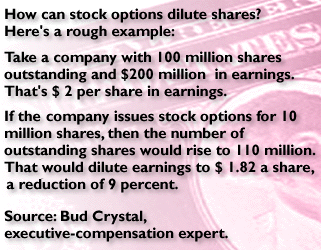|
Executive 'gravy train?'
|
 |
July 1, 1998: 7:41 p.m. ET
Shareholders say NYSE's broad-based options rule may be abused
|
NEW YORK (CNNfn) - A new rule at the New York Stock Exchange could leave ordinary investors with a smaller voice by allowing companies to award hefty stock option packages to executives without shareholder consent.
Critics claim the change, which took effect April 8, eats away at shareholders' rights at a time when executive compensation is skyrocketing. But supporters say the rule merely acknowledges a standard the exchange has used for a long time.
"You've got a loophole so wide you could drive six semi-trucks abreast through it," said Bud Crystal, an executive-compensation expert. "This says you can give out millions of shares behind the curtain to executives."
The NYSE in a statement said it didn't receive any opposition to the change before the Securities and Exchange Commission approved it.
But as a result of the criticism, the exchange reopened the public comment period until July 10 and created a task force to review the feedback. The panel may recommend revisions.
Defining "broad-based"
Stock options for executives have historically required shareholder approval, while "broad-based" plans haven't, the NYSE said. The new definition merely puts in writing a "rule of thumb" already used to describe broad-based plans, the NYSE said.
Under the rule, companies can enact without a shareholder vote any "broad-based" stock option plan that's open to at least 20 percent of the employees. Of the employees who are eligible, no more than half can be officers or directors.
Opponents argue a company has a lot of wiggle room because of the change. For example, the rule applies to companies where at least 20 percent of the employees are "eligible," rather than where the employees actually participate.
"A truly broad-based plan that motivates employees is OK," said Tom Flanagan, president of the Investors' Rights Association, a shareholder activist group. "But it's not just eligibility. It's participation that makes it broad-based."
The International Brotherhood of Teamsters, which holds $71 billion in pension assets, agrees broad-based plans should be based on employee participation, said Bart Naylor, director of corporate affairs in the Washington, D.C. office.
The Teamsters think the NYSE should define a broad-based plan as one where 70 percent of employees participate.

Still, Flanagan and Naylor said stock options take money out of shareholders' pockets. They're both on the new task force.
"Options are clearly a way in which excessive executive compensation is handed to a select group of insiders," Naylor said.
As of 1997, senior management controlled about 13 percent of the stock at the average U.S. company, Naylor said.
"That's a monumental shift in Corporate America from shareholders who are handed, essentially for free, these monumental ownership stakes," Naylor said.
It's hard to quantify how much options can dilute share prices, but Crystal gave the following rough example:
Take a company with 100 million shares outstanding and $200 million in earnings. That's $2 per share in earnings. If the company issues stock options for 10 million shares, then the number of outstanding shares would rise to 110 million. That dilutes earnings to $1.82 a share, a reduction of 9 percent.
In addition, it means outside investors have a smaller voice because their stake in the company has been watered down by the new shares.
Crystal compared issuing stock options to a war-torn government printing money for people to buy loaves of bread.
"You have companies running printing presses -- printing millions and millions of shares," Crystal said. "Shareholders should approve every last options plan."
-- by staff writer Martine Costello
|
|
|
|
|
 |

|

